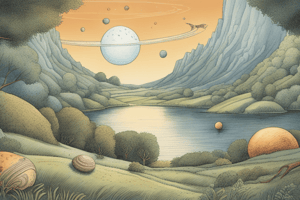Podcast
Questions and Answers
Which planets are considered to be rocky in the solar system?
Which planets are considered to be rocky in the solar system?
Mercury, Venus, Earth, Mars
What are the main components of the gas giants in the outer solar system?
What are the main components of the gas giants in the outer solar system?
Hydrogen and helium, with some water, methane, and ammonia
Which planet in the solar system is the only known habitable one?
Which planet in the solar system is the only known habitable one?
Earth
What kind of planets are found in the outer solar system?
What kind of planets are found in the outer solar system?
Signup and view all the answers
What are the possible compositions of the cores of Jupiter and Saturn?
What are the possible compositions of the cores of Jupiter and Saturn?
Signup and view all the answers
What are the main differences between the inner and outer planets in the solar system?
What are the main differences between the inner and outer planets in the solar system?
Signup and view all the answers
Study Notes
The solar system is a complex and diverse collection of celestial bodies that orbits the sun. At the heart of this system are the planets, which can be divided into two main categories: the inner, rocky planets, and the outer, gas giant planets.
Inner Solar System
The inner solar system consists of the planets Mercury, Venus, Earth, and Mars. These planets are rocky, and unlike the outer gas giants, they have a defined surface. They are believed to have formed from the accumulation of dust into small planetesimals, which then grew into proto-planets and finally into planets. Although Venus, Earth, and Mars are similar in composition, they have evolved differently. For example, Mars once had water on its surface, and there are hints that Venus may have, too, but Earth is the only known planet in the solar system that is habitable.
Outer Solar System
The outer solar system is home to the gas giants: Jupiter, Saturn, Uranus, and Neptune. Unlike the inner planets, these planets do not have a defined surface. They are primarily composed of hydrogen and helium, with some water, methane, and ammonia. At a certain point in their atmospheres, the gas on these planets transitions to a liquid state. Jupiter and Saturn probably have rocky cores surrounded by metallic hydrogen, while Uranus and Neptune are composed of rock, water, methane, and ammonia. Their outer atmospheres are comprised of hydrogen, which is similar to Jupiter and Saturn.
More than 100 moons orbit these planets of the outer solar system. Saturn's ring system is thought to be a pulverized moonlet.
Small Bodies
The small bodies of the solar system include comets, asteroids, objects in the Kuiper Belt and the Oort cloud, small planetary satellites, Triton, Pluto, Charon, and interplanetary dust. Some of these objects are believed to be almost unchanged since the young solar nebula formed our solar system 4.6 billion years ago, providing insight into the evolution of the planets and other bodies of the solar system.
In conclusion, the planets of the solar system, both inner and outer, are diverse in composition and evolution. The study of these planets helps us understand the formation and history of the solar system, as well as our place within it.
Studying That Suits You
Use AI to generate personalized quizzes and flashcards to suit your learning preferences.
Description
Explore the differences between the inner rocky planets (Mercury, Venus, Earth, Mars) and the outer gas giant planets (Jupiter, Saturn, Uranus, Neptune). Learn about their composition, characteristics, and evolution to understand the diversity within our solar system.




